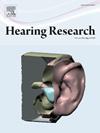清醒小鼠听觉皮层分层异常加工
IF 2.5
2区 医学
Q1 AUDIOLOGY & SPEECH-LANGUAGE PATHOLOGY
引用次数: 0
摘要
在环境中发现模式,并注意到意想不到的模式变化,是感觉处理的一个重要方面。适应和预测误差反应是与这些任务相关的神经加工的两个组成部分,先前在啮齿动物听觉系统中的研究表明,这两个组成部分在对感觉偏差的神经反应的地形和潜伏期方面是部分可分离的。然而,许多先前的研究都集中在单一刺激的重复上,例如纯音,其生态有效性有限。在这项研究中,我们测试了听觉皮层活动是否表现出对更复杂声音模式(双音节对)重复的适应性。具体来说,我们比较了仅基于单一刺激概率的违反序列的神经反应,以及基于刺激顺序的更复杂违反的神经反应。我们采用听觉怪异范式,并使用宽视场钙成像监测清醒小鼠(N = 8)的听觉皮层(AC)活动。我们发现皮质反应对单一刺激概率和更全面的刺激模式都很敏感,因为在替代偏差和换位偏差之后都会引发不匹配信号。值得注意的是,与初级交流区相比,高阶交流区向偏离者发出了更多的错配信号,这表明听觉皮层的预测误差信号存在层次梯度。这种等级梯度在钙异常的晚期峰值中被观察到,而不是早期峰值,这表明异常反应的晚期可能反映了对更复杂的感觉模式违规的预测错误信号。从动态环境中发现模式的意外变化对于感觉处理至关重要,因为它对人类和动物的生存至关重要。利用宽视场钙成像,我们研究了清醒小鼠的听觉皮层是否表现出预测错误信号的层次梯度及其对基于刺激特征和刺激顺序的序列违规的敏感性。我们发现高阶听觉皮层比初级听觉皮层对替换和转位异常者产生更显著的错配信号。钙对异常反应的瞬变在后期呈现层次梯度,而在早期峰值没有,这表明异常反应的后期可能反映了对更复杂的感觉模式违规的预测误差信号。本文章由计算机程序翻译,如有差异,请以英文原文为准。
Hierarchical deviant processing in auditory cortex of awake mice
Detecting patterns, and noticing unexpected pattern changes, in the environment is a vital aspect of sensory processing. Adaptation and prediction error responses are two components of neural processing related to these tasks, and previous studies in the auditory system in rodents show that these two components are partially dissociable in terms of the topography and latency of neural responses to sensory deviants. However, many previous studies have focused on repetitions of single stimuli, such as pure tones, which have limited ecological validity. In this study, we tested whether the auditory cortical activity shows adaptation to repetition of more complex sound patterns (disyllabic pairs). Specifically, we compared neural responses to violations of sequences based on single stimulus probability only, against responses to more complex violations based on stimulus order. We employed an auditory oddball paradigm and monitored the auditory cortex (AC) activity of awake mice (N = 8) using wide-field calcium imaging. We found that cortical responses were sensitive both to single stimulus probabilities and to more global stimulus patterns, as mismatch signals were elicited following both substitution deviants and transposition deviants. Notably, higher order AC area elicited larger mismatch signaling to those deviants than primary AC, which suggests a hierarchical gradient of prediction error signaling in the auditory cortex. Such a hierarchical gradient was observed for late but not early peaks of calcium transients to deviants, suggesting that the late part of the deviant response may reflect prediction error signaling in response to more complex sensory pattern violations.
Significance statement
Detecting the unexpected change of patterns from the dynamic environment is vital for sensory processing, as it is essential to survival for humans and animals. Using wide-field calcium imaging, we investigated whether the auditory cortex of awake mice exhibits a hierarchical gradient of prediction error signaling and its sensitivity to violations of sequences based on stimulus features and stimulus order. We discovered the high-order auditory cortex elicited more significant mismatch signaling to those deviants than primary auditory cortex in substitution and transposition deviants. Calcium transients to deviants showed a hierarchical gradient for late but not for early peaks, indicating that the late part of the deviant response may reflect prediction error signaling in response to more complex sensory pattern violations.
求助全文
通过发布文献求助,成功后即可免费获取论文全文。
去求助
来源期刊

Hearing Research
医学-耳鼻喉科学
CiteScore
5.30
自引率
14.30%
发文量
163
审稿时长
75 days
期刊介绍:
The aim of the journal is to provide a forum for papers concerned with basic peripheral and central auditory mechanisms. Emphasis is on experimental and clinical studies, but theoretical and methodological papers will also be considered. The journal publishes original research papers, review and mini- review articles, rapid communications, method/protocol and perspective articles.
Papers submitted should deal with auditory anatomy, physiology, psychophysics, imaging, modeling and behavioural studies in animals and humans, as well as hearing aids and cochlear implants. Papers dealing with the vestibular system are also considered for publication. Papers on comparative aspects of hearing and on effects of drugs and environmental contaminants on hearing function will also be considered. Clinical papers will be accepted when they contribute to the understanding of normal and pathological hearing functions.
 求助内容:
求助内容: 应助结果提醒方式:
应助结果提醒方式:


